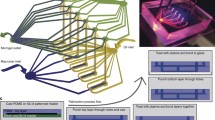Abstract
Microgel is a kind of biocompatible polymeric material, which has been widely used as micro-carriers in materials synthesis, drug delivery and cell biology applications. However, high-throughput generation of individual microgel for on-site analysis in a microdevice still remains a challenge. Here, we presented a simple and stable droplet microfluidic system to realize high-throughput generation and trapping of individual agarose microgels based on the synergetic effect of surface tension and hydrodynamic forces in microchannels and used it for 3-D cell culture in real-time. The established system was mainly composed of droplet generators with flow focusing T-junction and a series of array individual trap structures. The whole process including the independent agarose microgel formation, immobilization in trapping array and gelation in situ via temperature cooling could be realized on the integrated microdevice completely. The performance of this system was demonstrated by successfully encapsulating and culturing adenoid cystic carcinoma (ACCM) cells in the gelated agarose microgels. This established approach is simple, easy to operate, which can not only generate the micro-carriers with different components in parallel, but also monitor the cell behavior in 3D matrix in real-time. It can also be extended for applications in the area of material synthesis and tissue engineering.





Similar content being viewed by others
References
Amalvy JI, Wanless EJ, Li Y, Michailidou V, Armes SP (2004) Synthesis and characterization of novel pH-responsive microgels based on tertiary amine methacrylates. Langmuir 20(21):8992–8999
Avnir D, Coradin T, Levc O, Livage J (2006) Recent bio-applications of sol–gel materials. J Mater Chem 16(11):1013–1030
Chiou PY, Ohta AT et al (2005) Massively parallel manipulation of single cells and microparticles using optical images. Nature 436(7049):370–372
Dendukuri D, Doyle PS (2009) The synthesis and assembly of polymeric microparticles using microfluidics. Adv Mater 21(41):4071–4086
Du Y, Lo E et al. (2008) Directed assembly of cell-laden microgels for fabrication of 3D tissue constructs. Proceedings of the National Academy of Sciences 105(28):9522–9527
Ellis A, Jacquier JC (2009) Manufacture and characterisation of agarose microparticles. J Food Eng 90(2):141–145
Fiddes LK, Young EWK, Kumacheva E, Wheeler AR (2007) Flow of microgel capsules through topographically patterned microchannels. Lab Chip 7(7):863–867
Hayashi A, Kanzaki T (1987) Swelling of agarose gel and its related changes. Food Hydrocoll 1:317–325
Kawaguchi H, Suzuki D (2005) Gold nanoparticle localization at the core surface by using thermosensitive core-shell particles as a template. Langmuir 21:12016–12024
Ko JA, Park HJ, Hwang SJ, Park JB, Lee JS (2002) “Preparation and characterization of chitosan microparticles intended for controlled drug delivery”. Int J Pharm 249:165–174
Kumachev A, Greener J et al (2011) High-throughput generation of hydrogel microbeads with varying elasticity for cell encapsulation. Biomaterials 32(6):1477–1483
Lyon LA, Debord JD (2000) Thermoresponsive photonic crystals. J Phys Chem B 104(27):6327–6331
Oh JK, Drumright R et al (2008) The development of microgels/nanogels for drug delivery applications. Prog Polym Sci 33(4):448–477
Panda P, Ali S, Lo E, Chung BG, Hatton TA, Khademhosseini A, Doyle PS (2008) Stop-flow lithography to generate cell-laden microgel particles. Lab Chip 8(7):1056–1061
Sakai S, Hashimoto I et al (2008) Production of cell-enclosing hollow-core agarose microcapsules via jetting in water-immiscible liquid paraffin and formation of embryoid body-like spherical tissues from mouse ES cells enclosed within these microcapsules. Biotechnol Bioeng 99(1):235–243
Saunders BR, Vincent B (1999) Microgel particles as model colloids: theory, properties and application. Adv Colloid Interface Sci 80:1–25
Shi W, Wen H et al (2010) Droplet microfluidics for characterizing the neurotoxin-induced responses in individual Caenorhabditis elegans. Lab Chip 10(21):2855–2863
Tan WH, Takeuchi S (2007) Monodisperse alginate hydrogel microbeads for cell encapsulation. Adv Mater 19(18):2696–2701
Tumarkin E, Tzadu L et al (2011) High-throughput combinatorial cell co-culture using microfluidics. Integr Biol 3(6):653–662
Acknowledgments
This research was supported by the Joint Research Fund of NSFC-RGC (11161160522, N_HKUST601/11), Knowledge Innovation Program of the Chinese Academy of Sciences (KJCX2-YW-H18), and Instrument Research and Development Program of the Chinese Academy of Sciences (YZ200908).
Author information
Authors and Affiliations
Corresponding author
Rights and permissions
About this article
Cite this article
Shi, Y., Gao, X., Chen, L. et al. High throughput generation and trapping of individual agarose microgel using microfluidic approach. Microfluid Nanofluid 15, 467–474 (2013). https://doi.org/10.1007/s10404-013-1160-6
Received:
Accepted:
Published:
Issue Date:
DOI: https://doi.org/10.1007/s10404-013-1160-6




